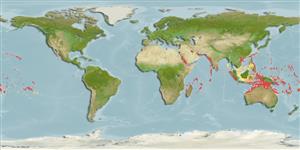>
Perciformes/Serranoidei (Groupers) >
Liopropomatidae (Painted basslets) > Liopropomatinae
Etymology: Liopropoma: Greek, leio = smooth + Greek, pro = in front of + Greek, poma, -atos = cover, operculum (Ref. 45335).
More on authors: Lubbock & Randall.
Issue
Type locality: Al Korae, Jeddah, Saudi Arabia.
Environment: milieu / climate zone / depth range / distribution range
Écologie
marin récifal; profondeur 3 - 46 m (Ref. 9710), usually 15 - 46 m (Ref. 9710). Tropical; 30°N - 24°S
Indo-Pacific: Red Sea to American Samoa and Tuamotu Archipelago, south to Australia.
Taille / Poids / Âge
Maturity: Lm ? range ? - ? cm
Max length : 9.0 cm TL mâle / non sexé; (Ref. 9710)
Épines dorsales (Total) : 8; Rayons mous dorsaux (Total) : 11 - 12; Épines anales: 3; Rayons mous anaux: 8. Reddish brown to gray, becoming redder posteriorly. L. mitratum differs from L. pallidum by having 14 rather than 15-16 pectoral rays and 19-30 rather than 8-13 preopercular serrae (Ref. 37816).
A secretive, ledge dweller species (Ref. 90102); benthic (Ref. 75154). and found in caves and crevices (Ref. 9710).
Life cycle and mating behavior
Maturité | Reproduction | Frai | Œufs | Fécondité | Larves
Randall, J.E. and L. Taylor, 1988. Review of the Indo-Pacific fishes of the serranid genus Liopropoma, with descriptions of seven new species. Indo-Pac. Fish. (16):47 p. (Ref. 6180)
Statut dans la liste rouge de l'IUCN (Ref. 130435: Version 2024-2)
Menace pour l'homme
Harmless
Utilisations par l'homme
Outils
Articles particuliers
Télécharger en XML
Sources Internet
Estimates based on models
Preferred temperature (Ref.
123201): 25.6 - 28.8, mean 27.5 °C (based on 286 cells).
Phylogenetic diversity index (Ref.
82804): PD
50 = 0.5000 [Uniqueness, from 0.5 = low to 2.0 = high].
Bayesian length-weight: a=0.01122 (0.00514 - 0.02450), b=3.04 (2.87 - 3.21), in cm total length, based on all LWR estimates for this body shape (Ref.
93245).
Niveau trophique (Ref.
69278): 3.6 ±0.6 se; based on size and trophs of closest relatives
Fishing Vulnerability (Ref.
59153): Low vulnerability (10 of 100).
Nutrients (Ref.
124155): Calcium = 121 [61, 242] mg/100g; Iron = 0.852 [0.429, 1.527] mg/100g; Protein = 18.4 [16.6, 20.2] %; Omega3 = 0.197 [0.114, 0.339] g/100g; Selenium = 26.2 [13.1, 51.6] μg/100g; VitaminA = 153 [48, 527] μg/100g; Zinc = 1.72 [1.12, 2.56] mg/100g (wet weight);
